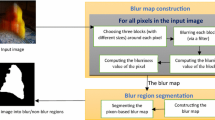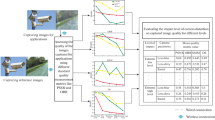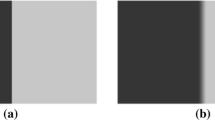Abstract
Videos and images have been widely used, and the requirements for camera imaging quality are getting higher and higher. At present, most methods of camera lens sharpness testing are divided into five areas: upper left, lower left, upper right, lower right, and middle. The test results of each area are used to approximate the overall sharpness level of the camera lens. The local sharpness failure of the camera lens cannot be solved by these methods. Because of this limitation, we proposed the idea of indirectly reflecting the local sharpness of the lens according to the image blur detection, and develop an image blur assessment method based on intensity and derivative (IDD). It can visualize the degradation process of camera sharpness from center to edge and the location of local failure. We demonstrate the feasibility and accuracy of the method through a case, as well as comparison to other methods.






Similar content being viewed by others
References
Sun C, Ai Y, Wang S, Zhang W (2021) Mask-guided SSD for small-object detection. Appl Intell 51:3311–3322. https://doi.org/10.1007/s10489-020-01949-0
Mao Q-C, Sun H-M, Zuo L-Q, Jia R-S (2020) Finding every car: a traffic surveillance multi-scale vehicle object detection method. Appl Intell 50:3125–3136. https://doi.org/10.1007/s10489-020-01704-5
Huang W, Gu J, Ma X, Li Y (2020) End-to-end multitask Siamese network with residual hierarchical attention for real-time object tracking. Appl Intell 50:1908–1921. https://doi.org/10.1007/s10489-019-01605-2
Gao L, Liu B, Fu P, Xu M, Li J (2021) Visual tracking via dynamic saliency discriminative correlation filter. Appl Intell 52:5897–5911. https://doi.org/10.1007/s10489-021-02260-2
Elharrouss O, Almaadeed N, Al-Maadeed S et al (2021) A combined multiple action recognition and summarization for surveillance video sequences. Appl Intell 51:690–712. https://doi.org/10.1007/s10489-020-01823-z
Zhang X-Y, Huang Y-P, Mi Y, Pei YT, Zou Q, Wang S (2021) Video sketch: a middle-level representation for action recognition. Appl Intell 51:2589–2608. https://doi.org/10.1007/s10489-020-01905-y
Wang F, Ai Y, Zhang W (2021) Detection of early dangerous state in deep water of indoor swimming pool based on surveillance video. SIViP 16:29–37. https://doi.org/10.1007/s11760-021-01953-y
ISO 12233:(2017) (en), Photography — Electronic still picture imaging — Resolution and spatial frequency responses. https://www.iso.org/obp/ui/#iso:std:iso:12233:ed-3:v1:en. Accessed 6 Jul 2021
Williams D, Wueller D, Matherson K, et al (2008) A pilot study of digital camera resolution metrology protocols proposed under ISO 12233, 2nd edn. SPIE 680804. https://doi.org/10.1117/12.768204
IEEE 1858-2016 - IEEE standard for camera phone image quality (2021) https://standards.ieee.org/standard/1858-2016.html. Accessed 6 Jul 2021
Estribeau M, Magnan P (2004) Fast MTF measurement of CMOS imagers at the chip level using ISO 12233 slanted-edge methodology. SPIE 557–567. https://doi.org/10.1117/12.565503
Artmann U (2016) Linearization and normalization in spatial frequency response measurement. Electronic Imaging 13:1–6. https://doi.org/10.2352/ISSN.2470-1173.2016.13.IQSP-011
Lin Z, Lei Z, Mou X, Zhang D (2011) FSIM: a feature similarity index for image quality assessment. IEEE Trans Image Process 20:2378–2386
Wang Z, Bovik AC, Sheikh HR, Simoncelli EP (2004) Image quality assessment: from error visibility to structural similarity. IEEE Trans Image Process 13:600–612. https://doi.org/10.1109/TIP.2003.819861
Soundararajan R, Bovik AC (2012) RRED indices: reduced reference entropic differencing for image quality assessment. IEEE Trans Image Process 21:517–526. https://doi.org/10.1109/TIP.2011.2166082
Wang Z, Simoncelli E (2005) Reduce-reference image quality assessment using a wavelet-domain natural image statistic model. Proc SPIE - Int Soc Opt Eng 5666. https://doi.org/10.1117/12.597306
Kim J, Nguyen A-D, Lee S (2019) Deep CNN-based blind image quality predictor. IEEE Trans Neural Netw Learning Syst 30:11–24. https://doi.org/10.1109/TNNLS.2018.2829819
Kim J, Lee S (2017) Fully deep blind image quality predictor. IEEE J Sel Top Signal Process 11:206–220. https://doi.org/10.1109/JSTSP.2016.2639328
Hosu V, Lin H, Sziranyi T, Saupe D (2020) KonIQ-10k: an ecologically valid database for deep learning of blind image quality assessment. IEEE Trans Image Process 29:4041–4056. https://doi.org/10.1109/TIP.2020.2967829
Golestaneh SA, Kitani K (2020) No-reference image quality assessment via feature fusion and multi-task learning. https://doi.org/10.48550/arXiv.2006.03783
Mittal A, Moorthy AK, Bovik AC (2012) No-reference image quality assessment in the spatial domain. IEEE Trans Image Process 21:4695–4708. https://doi.org/10.1109/TIP.2012.2214050
Moorthy AK, Bovik AC (2010) A two-step framework for constructing blind image quality indices. IEEE Signal Processing Letters 17:513–516. https://doi.org/10.1109/LSP.2010.2043888
Xue W, Mou X, Zhang L, Bovik AC, Feng X (2014) Blind image quality assessment using joint statistics of gradient magnitude and Laplacian features. IEEE Trans Image Process 23:4850–4862. https://doi.org/10.1109/TIP.2014.2355716
Saad MA, Bovik AC, Charrier C (2012) Blind image quality assessment: a natural scene statistics approach in the DCT domain. IEEE Trans Image Process 21:3339–3352. https://doi.org/10.1109/TIP.2012.2191563
Wu Q, Li H, Meng F, Ngan KN, Luo B, Huang C, Zeng B (2016) Blind image quality assessment based on multichannel feature fusion and label transfer. IEEE Trans Circuits Syst Video Technol 26:425–440. https://doi.org/10.1109/TCSVT.2015.2412773
Ye P, Kumar J, Kang L, Doermann D (2012) Unsupervised feature learning framework for no-reference image quality assessment. In: 2012 IEEE conference on computer vision and pattern recognition. 1098–1105. https://doi.org/10.1109/CVPR.2012.6247789
Moorthy AK, Bovik AC (2011) Blind image quality assessment: from natural scene statistics to perceptual quality. IEEE Trans Image Process 20:3350–3364. https://doi.org/10.1109/TIP.2011.2147325
Zhang L, Zhang L, Bovik AC (2015) A feature-enriched completely blind image quality evaluator. IEEE Trans Image Process 24:2579–2591. https://doi.org/10.1109/TIP.2015.2426416
Author information
Authors and Affiliations
Corresponding authors
Ethics declarations
Conflict of interest
The authors declare that they have no known competing financial interests or personal relationships that could have appeared to influence the work reported in this paper.
Additional information
Publisher’s note
Springer Nature remains neutral with regard to jurisdictional claims in published maps and institutional affiliations.
Appendix 1
Appendix 1
In Section 4, we compare the test results of seven reference-free image blur detection methods. The calculation process of the seven methods is as follows:
-
1.
Sobel:
Image Src convolute with 3*3 sobel operator. The average value after convolution is taken as the index of blur detection. The smaller the value, the more blurry the image.
Where GH is the horizontal blur degree, GV is the vertical blur degree.
-
2.
Tenegrad:
Similar to Sobel method. The smaller the value, the more blurry the image.
-
3.
Laplacian:
Using Laplacian to detect image blur is to conclute the imageSrcwith Laplacian operator:
-
4.
Brenner:
-
5.
$$ {B}_H=\sum \limits_x\sum \limits_y\mid f\left(x,y+2\right)-f\left(x,y\right)\mid $$(22)
-
6.
$$ {B}_V=\sum \limits_x\sum \limits_y\mid f\left(x+2,y\right)-f\left(x,y\right)\mid $$(23)
Where BH is the horizontal blur degree, BV is the vertical blur degree. The smaller the value, the more blurry the image.
-
7.
Gray-scale variance:
This method only has the overall blur indexD:
-
8.
Energy gradient:
Similar to method 5. This method also only has the overall blur indexE:
-
9.
Vollath:
-
10.
$$ V=\sum \sum f\left(x,y\right)\ast f\left(x+1,y\right)-M\ast N\ast {\mu}^2 $$(26)
Where M, N is the size of image, and μ is the average of image pixels.
Rights and permissions
Springer Nature or its licensor holds exclusive rights to this article under a publishing agreement with the author(s) or other rightsholder(s); author self-archiving of the accepted manuscript version of this article is solely governed by the terms of such publishing agreement and applicable law.
About this article
Cite this article
Wang, F., Chen, J., Xie, Z. et al. Local sharpness failure detection of camera module lens based on image blur assessment. Appl Intell 53, 11241–11250 (2023). https://doi.org/10.1007/s10489-022-03948-9
Accepted:
Published:
Issue Date:
DOI: https://doi.org/10.1007/s10489-022-03948-9




